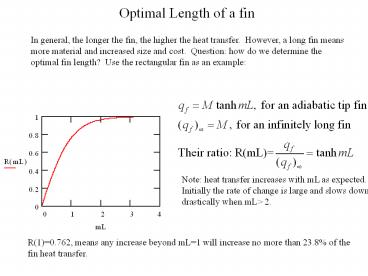Optimal Length of a fin - PowerPoint PPT Presentation
1 / 3
Title:
Optimal Length of a fin
Description:
Optimal Length of a fin. In general, the longer the fin, the higher the heat transfer. However, a long fin means more material and increased size and cost. ... – PowerPoint PPT presentation
Number of Views:23
Avg rating:3.0/5.0
Title: Optimal Length of a fin
1
Optimal Length of a fin
In general, the longer the fin, the higher the
heat transfer. However, a long fin means more
material and increased size and cost. Question
how do we determine the optimal fin length? Use
the rectangular fin as an example
Note heat transfer increases with mL as
expected. Initially the rate of change is large
and slows down drastically when mLgt 2.
R(1)0.762, means any increase beyond mL1 will
increase no more than 23.8 of the fin heat
transfer.
2
Temperature Distribution
- Use m5, and L0.2
- as an example
Low DT, poor fin heat transfer
High DT, good fin heat transfer
3
Correction Length for a Fin with a Non-adiabatic
Tip
- The correction length can be determined by using
the formula LcL(Ac/P), where Ac is the
cross-sectional area and P is the perimeter of
the fin at the tip. - Thin rectangular fin AcWt, P2(Wt)?2W, since
t ?lt W LcL(Ac/P)L(Wt/2W)L(t/2) - Cylindrical fin Ac(?/4)D2, P ?D,
LcL(Ac/P)L(D/4) - Square fin AcW2, P4W, LcL(Ac/P)L(W2/4W)L
(W/4)

